In working with consumer brands, we regularly encounter confusion between the concepts of Identity Resolution and Device Graphs. This blog post seeks to clarify the terminology and help marketers find the right technology solution for their needs.
Identity Resolution
Identity Resolution is the process of bringing together Personally Identifiable Information (PII) like email addresses, first and last names, mailing addresses, and phone numbers, and connecting it to transactional data, preferences, and behavioral data at the individual level to form known-customer profiles. This includes any customer data source including PII: online, offline, on-site and in-store. The result is unified, 360-degree views of each of a brand’s unique customers. These customer views can be segmented based on hundreds of attributes to fuel personalized marketing and customer experiences in all customer channels (including email, direct mail, advertising, web, app, and even in-person interactions).
For example, after the process of identity resolution has taken place, an airline can easily create a segment of people who have flown to Denver in the last 12 months, who have not checked a bag, have the airline’s credit card, and are opted in to email communications. This sample segment could be used for highly targeted marketing campaigns across a variety of digital and non-digital channels.
Before the process of identity resolution, building this segment across disconnected operational, marketing, and financial databases is virtually impossible. It’s unusual for data users to even have access to all of these systems, let alone a resolved and actionable view of individuals.
Probabilistic Identity Resolution
Probabilistic identity resolution takes this process a step further by using machine learning algorithms to assign likelihoods to connections for records within and across data sources. This is especially valuable when data sources lack common keys. The result is a richer and more precise set of profiles that leverage more of a brand’s customer data and allow profiles to be adjusted based on their intended use case.
Device Graphs
Device graphs, by comparison, are a cluster of browsers and devices that have been probabilistically connected using anonymous, non-PII data sources like ad server logs, cookie IDs, device IDs, browser fingerprints, and IP addresses from the open web, and are unified around individual, but anonymous users. Device graphs are used by brands to show targeted web ads and content to unique users across all their different browsers and devices.
Imagine a home goods retailer knowing that someone using a specific web browser looked at a sofa but didn’t buy, and then retargeting that user with sofa ads across all browsers and devices associated with that user.
Vendors operating in the device graph space come in two forms. The first are “walled gardens” like Amazon, Facebook, and Google who through their vast reach and repeated login have a strong sense of a person’s footprint across browsers and devices over time. The second set are companies like TapAd and Drawbridge who build probabilistic device graphs from participating publishers, user panels, and third-party data.
To learn more about how Amperity Customer Data Platform probabilistically resolves customer identities, contact us for a product demo.
